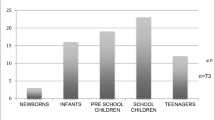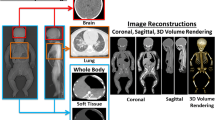Abstract
Background
Postmortem computed tomography (CT) and magnetic resonance imaging have been gradually introduced to forensic pathology centres over the past two decades, with varying results in comparison to autopsy.
Objective
The purpose of this study was to determine the accuracy of postmortem CT in determining a cause of death in children who died of unnatural causes.
Materials and methods
This was a prospective recruitment of 30 children (< 18 years) who underwent postmortem CT and a forensic autopsy. A cause of death was independently assigned by two experienced paediatric radiologists and compared to that of the forensic autopsy.
Results
A correct cause of death was assigned by reviewers 1 and 2 in 70% (n = 21/30) and 67% (n = 20/30) of cases, respectively. For gunshot injuries and blunt force head injuries, there was 91% (n = 10/11) and 100% (n = 6/6) agreement between forensic autopsy and both reviewers, respectively. No cause of death could be assigned by reviewers 1 and 2 in 27% (n = 8) and 30% (n = 9) of cases, respectively. An incorrect cause of death was assigned by both reviewers in one case (3%). The Cohen Kappa level of agreement between the forensic autopsy and reviewers 1 and 2 was k = 0.624 (95% confidence interval [CI]: 0.45–0.80, P = 0) and k = 0.582 (95% CI 0.41–0.76, P = 0), respectively. There was near perfect agreement between reviewers 1 and 2 (k = 0.905) (95% CI 0.78–1.00, P = 0).
Conclusion
Postmortem CT has good diagnostic accuracy for identifying a cause of death related to trauma, but it has poor accuracy for children dying from causes not associated with apparent physical injury.





Similar content being viewed by others
Change history
09 August 2022
A Correction to this paper has been published: https://doi.org/10.1007/s00247-022-05471-y
References
Pomara C, Fineschi V, Scalzo G, Guglielmi G (2009) Virtopsy versus digital autopsy: virtual autopsy. Radiol Med 114:1367–1382
Ruder TD, Hatch GM, Thali MJ, Fischer N (2011) One small scan for radiology, one giant leap for forensic medicine – Post-mortem imaging replaces forensic autopsy in a case of traumatic aortic laceration. Leg Med (Tokyo) 13:41–43
Thali MJ, Yen K, Vock P et al (2003) Image guided virtual autopsy findings of gunshot victims performed with multi-slice computed tomography (MSCT) and magnetic resonance imaging (MRI), and subsequent correlation between radiology and autopsy findings. Forensic Sci Int 138:8–16
Yen K, Lӧvblad K-O, Scheurer E et al (2007) Post-mortem forensic neuroimaging: correlation of MSCT and MRI findings with autopsy results. Forensic Sci Int 173:21–35
Shiotani S, Shiigai M, Ueno Y et al (2008) Postmortem computed tomography findings as evidence of traffic accident-related fatal injury. Radiat Med 26:253–260
Scholing M, Saltzherr TP, Fung Kon Jin PHP et al (2009) The value of postmortem computed tomography as an alternative for autopsy in trauma victims: a systematic review. Eur Radiol 19:2333–2341
Kasahara S, Makino Y, Hayahawa M et al (2012) Diagnosable and non-diagnosable causes of death by post-mortem computed tomography: a review of 339 cases. Leg Med (Tokyo) 14:239–245
Daly B, Abboud S, Ali Z et al (2013) Comparison of whole-body postmortem 3D CT and autopsy evaluation in accidental blunt force traumatic death using the abbreviated injury scale classification. Forensic Sci Int 225:20–26
Le Blanc-Louvry I, Thureau S, Duval C et al (2013) Post-mortem computed tomography compared to forensic autopsy findings: a French experience. Eur Radiol 23:1829–1835
Leth PM, Thomsen J (2013) Experience with post-mortem computed tomography in Southern Denmark 2006–2011. J Forensic Radiol Imaging 1:161–166
Noda Y, Yoshimura K, Tsuji S et al (2013) Postmortem computed tomography imaging in the investigation of nontraumatic death in infants and children. Biomed Res Int 2013:327903
Proisy M, Marchand A, Loget P et al (2013) Whole-body post-mortem computed tomography compared with autopsy in the investigation of unexpected death in infants and children. Eur Radiol 23:1711–1719
Sieswerda-Hoogendoorn T, Soerdjbalie-Maikoe V, De Bakker H, van Rijn RR (2014) Postmortem CT compared to autopsy in children: concordance in a forensic setting. Int J Legal Med 128:957–965
Ampanozi G, Thali YA, Schweitzer W et al (2017) Accuracy of non-contrast PMCT for determining cause of death. Forensic Sci Med Pathol 13:284–292
Arthurs OJ, Guy A, Thayyil S et al (2016) Comparison of diagnostic performance for perinatal and paediatric post-mortem imaging: CT versus MRI. Eur Radiol 26:2327–2336
Krentz BV, Alamo L, Grimm J et al (2016) Performance of post-mortem CT compared to autopsy in children. Int J Legal Med 130:1089–1099
van Rijn RR, Beek EJ, van de Putte EM et al (2017) The value of postmortem computed tomography in paediatric natural cause of death: a Dutch observational study. Pediatr Radiol 47:1514–1522
Bryce CH (2013) The impact of advances in post-mortem imaging on forensic practice. Forensic Sci Criminol 1:1–2
Shelmerdine SC, Davendralingam N, Palm L et al (2019) Diagnostic accuracy of postmortem CT of children: a retrospective single-center study. AJR Am J Roentgenol 212:1335–1347
McLeod S (2019) What is the central limit theorem in statistics? Simply Psychology. www.simplypsychology.org/central-limit-theorem.html. Accessed 23 March 2022
LaMorte W (2020) Central limit theorem. The role of probability. Boston University School of Public Health. https://sphweb.bumc.bu.edu/otlt/MPH-Modules/BS/BS704_Probability/BS704_Probability12.html. Accessed 28 Dec 2020
World Health Organisation (2014) Health topics: child maltreatment. http://www.who.int/topics/child_abuse/en/. Accessed 8 June 2014
Carrol R, Wood J (2012) Sudden unexpected infant death: a compassionate forensic approach to care. Clin Pediatr Emerg Med 13:239–248. https://doi.org/10.1016/j.cpem.2012.06.011
National Association of Medical Examiners (2005) Forensic autopsy performance standards. https://www.thename.org/assets/docs/2016%20NAME%20Forensic%20Autopsy%20Standards%209-25-2020.pdf. Accessed 27 Dec 2021
Home Office, The Forensic Science Regulator, Department of Justice and the Royal College of Pathologists (2012) Code of practice and performance standards for forensic pathology in England, Wales and Northern Ireland. https://www.rcpath.org/uploads/assets/5617496b-cd1a-4ce3-9ec8eabfb0db8f3a/Code-of-practice-and-performance-standards-for-forensic-pathology-in-England-Wales-and-Northern-Ireland.pdf. Accessed 27 Dec 2021
World Health Organisation (2011) International statistical classification of diseases and related health problems, 10th revision, vol. 3; Alphabetical index, 5th edn. www.who.int/classifications/icd/icdonlineversions/en/. Accessed 5 Feb 2018
Andenmatten MA, Thali MJ, Kneubuehl BP et al (2008) Gunshot injuries detected by post-mortem multislice computed tomography (MSCT): a feasibility study. Leg Med 10:287–292
Filograna L, Tartaglione T, Filograna E et al (2010) Computed tomography (CT) virtual autopsy and classical autopsy discrepancies: radiologist’s error or a demonstration of post-mortem multi-detector computed tomography (MDCT) limitation? Forensic Sc Int 195:e13–e17
Ramasamy A, Hinsley DE, Brooks AJ (2015) The use of improvised bullet markers with 3D CT reconstruction in the evaluation of penetrating trauma. J R Army Med Corps 154:239–241
Breitbeck R, Sekula A, Thali MJ et al (2014) Use of radiopaque markers in reconstruction of gunshot injuries. J Forensic Radiol Imaging 2:97
Poulsen K, Simonsen J (2007) Computed tomography as routine in connection with medico-legal autopsies. Forensic Sci Int 171:190–197
Dirnhofer R, Jackowski C, Vock P et al (2006) Virtopsy: minimally invasive imaging guided virtual autopsy. Radiographics 26:1305–1333
Homsi M, Companioni RAC, Panchal A et al (2017) The role of abdominal CT in management of acute gastroenteritis. Am J Gastroenterol 112:S612–S613
Childers B, Cater S, Horton K et al (2015) CT Evaluation of acute enteritis and colitis: is it infectious, inflammatory or ischemic. Radiographics 35:1940–1941
Jalalzadeh H, Giannakopoulosm G, Berger F et al (2015) Post-mortem imaging compared with autopsy in trauma victims – a systematic review. Forensic Sci Int 257:29–48
Acknowledgements
This study was approved by the Human Research Ethics Committee of the University of Cape Town and all relevant ethical requirements were upheld in accordance with the Declaration of Helsinki (1964) and later amendments
Author information
Authors and Affiliations
Corresponding author
Ethics declarations
Conflicts of interest
None
Additional information
Publisher's note
Springer Nature remains neutral with regard to jurisdictional claims in published maps and institutional affiliations.
The original online version of this article was revised: The correct contact information for Lorna J. Martin is: 3 Division of Forensic Medicine & Toxicology, Department of Pathology, Faculty of Health Sciences, University of Cape Town, Cape Town, South Africa The correct keywords are: Keywords Autopsy · Cause of death · Child fatalities · Children · Computed tomography · Forensic · Postmortem
Rights and permissions
Springer Nature or its licensor holds exclusive rights to this article under a publishing agreement with the author(s) or other rightsholder(s); author self-archiving of the accepted manuscript version of this article is solely governed by the terms of such publishing agreement and applicable law.
About this article
Cite this article
Speelman, A.C., Engel-Hills, P.C., Martin, L.J. et al. Postmortem computed tomography plus forensic autopsy for determining the cause of death in child fatalities. Pediatr Radiol 52, 2620–2629 (2022). https://doi.org/10.1007/s00247-022-05406-7
Received:
Revised:
Accepted:
Published:
Issue Date:
DOI: https://doi.org/10.1007/s00247-022-05406-7




